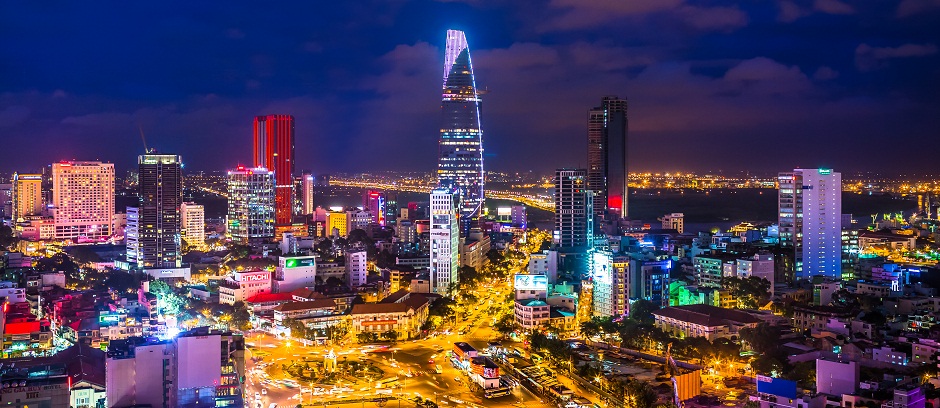HO CHI MINH CITY
Ho Chi Minh City is the largest city in Vietnam. Under French colonial rule, the city was referred to as Saigon, a name that is still often used today.
Ho Chi Minh City is the largest city in Vietnam. Under French colonial rule, the city was referred to as Saigon, a name that is still often used today. The city center is situated on the banks of the Saigon River, 60 kilometers (37 mi) from the South China Sea and 1,760 kilometers (1,094 mi) south of Hanoi, the capital of Vietnam.
The metropolitan area consists of about 9 million people, making it the most populous metropolitan area in Vietnam and Indochina as a whole. The Greater Ho Chi Minh City Metropolitan Area, a metropolitan area covering most part of Dong Nam Bo plus Tien Giang and Long An provinces (30,000km), is expected to have a population of 20 million inhabitants by 2020.
Ho Chi Minh City operates at two speeds: fast and faster. The central business district is rapidly developing, while the old Saigon lives on among wide avenues flanked by elegant colonial buildings. Hectic and electric, traditional and modern, Ho Chi Minh city is a study in contrasts as it leads the change of a young country rapidly opening up to the rest of the world. The central downtown area is in district 1. Sites of interest include the Historical Museum, the Reunification Hall and the War Remnants Museum.
Nowadays, Ho Chi Minh City is an enormous tourism centre of the whole country. Coming to the country, tourists can visit ancient architectures such as the Central post office of the city, Large Opera -House, People's Committee of the city, and Ben Thanh Market or they may go to have a look at the system of the old-age churches like The Church of Madonna, Huyen Sy Church, Thong Tay Hoi Church, etc. Besides, Sai Gon River circling around the central area connects with other branches of rivers and entangled canals. This great river is very convenient for waterway traffic and tourism. Bach Dang (Bạch Đằng) Wharf and Nha Rong (Nha Rong) Wharf are close-knit to harbours which are always wind-swept and crowded with yachts.
The centre of this city also contains many streets like Dong Khoi, Nguyen Hue or Le Loi that are all famous for Western architectural styles, hotels, restaurants, coffee shops, bars, fine art shops, antique stores, galleries with paintings and statues, "ao dai" fashion of Vietnam, and so on.
Sai Gon - Ho Chi Minh City is a sparkling pearl which is resplendent along the side of East Sea and is an ideal destination for excursionists from the four corners of the earth.

Weather
Ho Chi Minh City has pleasant climate with two seasons: dry season and rainy season. At here, rain is quick to cease and sunshine is not too hot. Because of the geographic position and its convenient climate, the city is also the converging place of many ethnic groups. Each ethnic group has its own religion and distinct culture and they all have contributed in making a multicultural environment. The special trait of this land is the harmonious combination between the national tradition and cultural features of the North (China) and the Western countries. That has created the lifestyle and characteristics of Sai Gon people. They are faithful, straightforward, broad-minded and energetic and have skills and strong-willed spirit.
Located on the southeastern part of Vietnam, on the right bank of River Saigon, Ho Chi Minh City has a tropical climate. Its location being very close to the sea, climate of the city steadily varies from warm to hot through out the year.
There are mainly two seasons in this city. The rainy season starts from May and lasts till late November. Downpour becomes heavy from June to August. However the showers are usually sudden and stay for a brief period. So even during the rainy season reappearance of Sun occurs fairly quickly. The average rainfall of the city is around 1,800 mm.
Temperature goes down a bit from December to April. This particular time period is considered as the dry season. The average temperature during the dry season stays around 28 degree Celsius. The temperature may rise upto 39 degree Celsius around noon during late April. However it may drop below 16 degree Celsius during the morning hours in late December.
July to November is the time for typhoons. The average humidity of the Ho Chi Minh City is around 80 percent. April is the hottest month of the city. On the other hand December is the coolest one. However in general the climate of the city is hot and humid.
Geography
Ho Chi Minh City (former Saigon) is the economic capital of Vietnam. It is situated by the side of the Saigon River towards the northern part of the Mekong River delta.
Placed at 10°45'N, 106°40'E in the southeastern part of Vietnam, the city is 1725 km away from the southern Hanoi and 50 km west of the Eastern Sea.
It is enclosed by Tay Ninh and Binh Duong provinces in the north, Dong Nai and Ba Ria - Vung Tau provinces in the east and Long An Province in the west. A stretch of 20-km coastline of the South China Sea lies along its southern end.
The city occupies an area of 2,095 square km (809 square mile). Its north-south stretch from the Phu My Hung Commune in Cu Chi District (northernmost point) to the Long Hoa Commune in Can Gio District (southernmost point) covers 120 km. The east-west stretch, extending from the Long Binh Ward in District Nine (easternmost point) to Binh Chanh Commune of Binh Chanh District, covers 46 km. The city is situated at a height of 19 meters (63 feet) above the sea surface.
History
A bunch of hundreds of small rivers and channels watering the Cuu Long delta has been a prominent geographic feature of Saigon. Accessibility to 50,000 tone vessels constitutes one of the biggest advantages of this city. It is well connected with all Southern provinces of Vietnam through highways. The last station of the trans-Vietnam railway is also situated in Ho Chi Minh City.
One of the earliest known records of the area now known as Ho Chi Minh City says that it was a small fishing village called Prey Nokor, inhabited by Khmer people. In the year 1623 Vietnamese refugees fled from the civil war in Vietnam and settled in Prey Nokor (which was a part of Cambodia then) with the permission of the king of Cambodia. Gradually more Vietnamese refugees migrated to this area and this place came to be known as Saigon.
With the colonization of Vietnam by France in 1858 the city officially ceded to the French in 1859.The colonization influence this city heavily, so much so, that it was called “Paris in the Orient”. Many of the old colonial buildings and villas still stand today and hark of those times.
In 1954, Communist Viet Minh defeated the French in the Battle of Dien Bien Phu, and the French withdrew from Vietnam. However the Communists were not recognized as the new government. The Emperor Bao D?i became the head of state and set up Saigon as his capital. During this time Saigon and the area of Cholon were combined into one city. Vietnam was partitioned into the Democratic Republic of Vietnam and the Republic of Vietnam. The latter, led by President Ngo Dinh Diem, made Saigon its capital.
When the Vietnam War ended on April 30, 1975, the city came under the jurisdiction of the Vietnam People's Army. This event is referred to as the "Liberation of Saigon."
In 1976, unified communist Socialist Republic of Vietnam came into being, the city of Saigon, the province of Gia D?nh and other districts merged to create Ho Chi Minh City to commemorate the late communist leader Ho Chi Minh.
Today, the city centre boasts of broad elegant boulevards and historic French colonial buildings, war and history museums and ancient pagodas.
